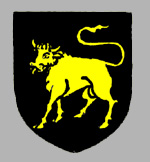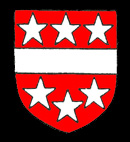The Manor of Clapham Greenacres alias FitzJeffry
Volume III of The Victoria County History for Bedfordshire was published in 1912 and contains accounts of the various manors in Clapham. The Manor of Clapham Greenacres alias Fitzjeffrys was originally part of the Manor of Clapham and was held of the Honour of Wallingford [Oxfordshire] as overlord; the overlordship is last mentioned in 1617.
The first known tenant of the manor is William Maudit, 8th Earl of Warwick (c.1220-1267) who alienated it to William le Brun - the manor then included a fishery on the River Great Ouse. In 1278 John le Brun held just over three hides in Clapham as noted on the Hundred Roll, two-fifths of the manor, the rest being held by John de Burnaby, Ralf de Wedon and Walter Burdun John le Brun’s heir was his daughter, Sarah, who married Henry Spigurnel, who died in 1328 holding the whole manor except a few acres. Thomas Spigurnel alienated the manor to Sir Bartholomew Burgherssh in 1344. Burgherssh died in 1355 leavig a son of the same name as heir.
In 1380 Richard Greenacre died holding the manor, which then comprised 402 acres of arable, 16 acres of meadow and several pastures - the whole thing was worth £7/13/4 per annum. Greenacre was succeeded by his son of the same name and he was survived by his wife Isabel who then married John Dymoke - she died in 1415. Her son John Greenacre succeeded to the manor but by 1428 Henry Cokayn held the manor and in 1455 it was Thomas Srathum, who sold it to John FitzJeffrey who died owning it in 1480 and his family remained as lords of the manor until 1562 when Leonard FitzJeffrey alienated the manor to alderman Thomas Rowe of London.

Arms of the FitzJeffrey family
The Rowe family held the manor until 1592 when Rowe’s successor Thomas Rowe of Trumpington [Cambridgeshire] sold the manor for £3,644 to George Wyatt, Edward Scanden, John Wright and Valentine Saunders, trustees for recusant Arden Waferer to whom Rowe was indebted. Waferer died in 1617 leaving the manor to his wife Elizabeth until his son James reached the age of twenty five. Elizabeth, also a Roman Catholic, refused to attend church and two-thirds of her property was seized by the Crown when she refused to pay the attendant fine. In 1627 James Waferer alienated the manor to Richard Taylor, a serjeant-at-law.
The manor was sequestrated by parliament in 1649 due to the support given to the Royalist cause in the civil wars by Taylor’s eldest son Richard. However, the sequestration was confined to Richard’s share in 1651 and not extended to those of his younger brothers, one of whom, William, was the captured fighting for the king at Chester. Thomas Taylor was lord of the manor in 1655 and left the manor to his wife Ursula for her life. His heir was his daughter Katherine who married William, 2nd Baron Ashburnham and they seem to have succeeded to the manor before the death of Ursula Taylor.

Ashburnham Arms
After Lord Ashburnham’s death his son John, 1st Earl of Ashburnham succeeded to the manor which then remained in the family until 1862 when most of the estates were sold to James Howard, Liberal MP for Bedford and son of the founder of the Howard engineering business operating from Britannia Iron and Steel works in Kempston Road, Bedford. By 1912 all manorial rights had lapsed.
The manor was still standing in 1812 [BS188] and is mentioned as "the fast decaying remains of the ancient grange" by John Martin in 1847. It was near the west end of the church, close to the site of the current Ursula Taylor School. Sale particulars state: "The buildings on this lot are very desirable to the purchaser of either Lots 6, 11, 12 or 16, to be used in their present condition, or to be taken down and re-erected upon either of the first three of those lots; and there being no house or land belonging to the Vicarage in this parish, it is desirable to annex it to Lot 16". The tenant of the manor house was then Mrs Tossell.
![The church from the east by Bradford Rudge in 1840, the manor house can be seen behind the west tower [Z50/29/10]](/CommunityHistories/Clapham/Clapham-Images/The-church-from-the-east-by-Bradford-Rudge-in-1840-Z50-29-10.jpg)
The church from the east by Bradford Rudge in 1840, the manor house can be seen behind the west tower [Z50/29/10]